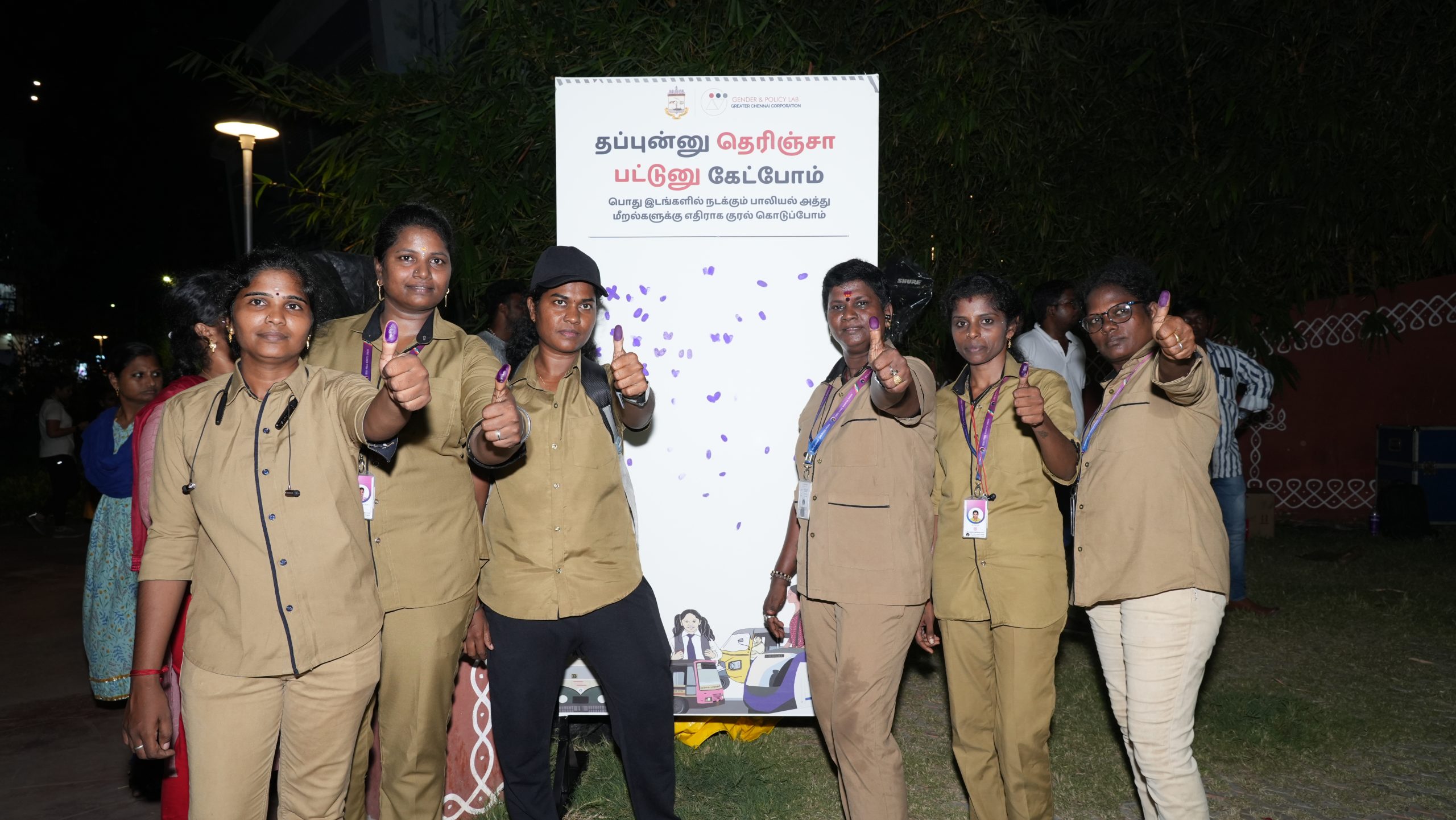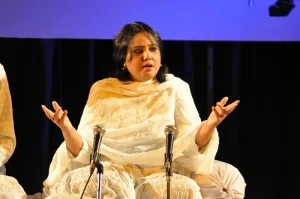Why A Roomful Of Bright Young Chennai Women Refused To Discuss Harassment
Tamil Nadu boasts fantastic gender indicators but some subjects still remain a taboo, which shows that deep-set social attitudes take longer to change
- Meera Sundararajan

I was facilitating a discussion on some films screened as part of a film festival at a famous women’s college in Chennai. The films dealt with themes such as informed consent in intimate relationships, toxic masculinity and public place harassment.
Two films on harassment of women in public spaces got loud applause with meaningful glances being exchanged across the room. I was expecting an animated discussion post-screening. However when the films ended, I found myself facing a wall of silence.
To put the students at ease, I began discussing the films on harassment in public places since this would most likely resonate with the audience. But the palpable discomfort in the room continued. To break the ice, I changed the question, asking if anyone had experienced restrictions or discrimination at home. This seemed to be more in their comfort zone, and they began talking about restrictions on mobility, on selecting subjects for college and so on. But the issues of sexual harassment, domestic violence and consent in intimate partner relationships portrayed in films screened remained unaddressed.
While, it was quite possible that the students were preoccupied with upcoming classes or lunch break, I could not but be reminded of a similar situation I was in four decades ago. I was in school then, and when we had a session on sex education, all of us remained silent when the doctor facilitating the session encouraged us to speak. The question that haunts me today is this – are there topics that remain taboo for women even today in public discussions?
Women’s Development As State Priority
I have worked for over three decades in Tamil Nadu’s social sector and take pride in the state’s gender indicators – as per 2011 census it stands third in female literacy, after Kerala and HImachal Pradesh, with a female work participation rate that is higher than the national average and with a total fertility rate at 1.4 and ready to hit population stabilisation by 2035. On crime, the National Crime Records Bureau’s 2022 data shows that while the rate of reported crimes against women nationally per lakh population in the country was 66.4, Tamil Nadu’s was about a third.
Tamil Nadu has been consistently on the forefront on programmes and schemes for women. It had a vibrant, grassroot level institution-building programme dating back to 1989 and supported by the International Fund for Agriculture and Development, followed by the fully state funded 1997 programme, Mahalir Thittam (women’s programme). These programmes reached out to women through savings, credit and livelihood support initiatives.
In 2005, this programme in its expansion phase gave way to the Vazhndhu Kaattuvom (we demonstrate how to live) project supported by the World Bank. Today, Tamil Nadu has a total of 3,18,912 self-help groups with a membership of 34,76,929 women which is about 10% of the total women in the state and 18% of rural women.
Service Delivery vs Exercising Of Rights
Brazilian educator and philosopher Paulo Freire in his book “Pedagogy of the Oppressed” discusses a concept called “conscientization”, which refers to how individuals and communities develop a critical understanding of their social reality through reflection and action on the root causes of oppression. If we were to apply this to the mass mobilisation of women in Tamil Nadu we would find a glaring gap.
The theory of change followed in the mobilisation of women in Tamil Nadu has been a bit simplistic, assuming that economic development alone would result in empowerment. Though there have been anecdotal cases of self-help groups taking up gender based violence and prevention of child sexual abuse, economics had always been their primary goal.
Tamil Nadu has today started recognising and acknowledging the importance of women’s safety in the domestic and the public domain with a push coming from agencies like the World Bank.
However, the implementation journey for these projects is like walking on eggshells because the issues they focus on are sensitive and it needs a carefully planned approach to break the decades of silence surrounding these. Additionally there is no existing body of knowledge within the socio cultural context to draw lessons from.
The Gender and Policy Lab, that I am a part of, was set up by the Greater Chennai Corporation in February 2022. A first of its kind effort by any urban local body, it was conceptualised to mainstream gender concerns in public infrastructure planning and public transport while putting women’s safety in the centre. About six months into our existence, we undertook a study to get an idea about women’s perception of safety in Chennai city. The results were a bit startling: of the 2400 women respondents, only 12%-22% mentioned facing some form of harassment in public spaces and public transport. These numbers appear to be much lower when compared to findings from a study done in three cities of Kerala by its state government – over 50% of the women interviewed said they experienced harassment. This 2021 study was on the gender sensitive reforms in Kerala’s public transport reforms.
There were other troubling findings. Of all the women who said they were harassed, 62% said no bystander intervened and when there was an intervention it was from the police or through an acquaintance. The study also revealed that only 17% of respondents knew about the state government’s women’s helpline 181, though more respondents (39%) seemed more aware of the police SOS app, Kavalan Uthaivi.
Law Enforcement
Chennai has a very visible police presence on its streets. Along with other police patrol vehicles, one cannot miss seeing the pink ones with their all-women police squad. A mock drill conducted by the Gender and Policy Lab team in July 2023 showed the response time to an SOS to be 8-11 minutes during peak traffic time in highly congested areas, which is commendable. However, the complaints that the police receive from women on harassment in public spaces has been low, with most complaints being on crimes such as bag/ chain/ mobile snatching.
This brings us to the question of whether violence against women in Chennai is so low that it has lulled women into thinking it is actually a non-issue or is it something that lurks below the surface, unarticulated?
The NFHS 5 Survey, found that, where 45.4% women and 44% men in India justified domestic violence for certain specified reasons, such as “disobeying husband”, in Tamil Nadu, 78.3% women and 56.2% men agree with at least one specified reason. Yet, no one talks about these numbers.
We, therefore, have a strange situation where the state is ready to deploy resources but the demand for these is low.
To get people to acknowledge the issue of public place harassment of women, we launched a campaign with two films on bystander intervention. While women do relate strongly to the situations being portrayed in the films, the message to the public to intervene will probably take a longer time to sink in. There is still a feeling that women “ask for it” because they put themselves into “risky” situations.
Chennai is a city that believes in “minding your own business”. A recent example of this is the fact that unlike Bangalore, Mumbai and Delhi, there was only one public protest in the city against the murder and rape of a doctor at the RG Kar hospital in Kolkata. It was also the last city to hold a public protest.
Getting Chennai To Speak Up
Public campaigns: Social campaigns bring awareness generation and attitude change through capacity building. Campaigns on family planning, immunisation and girls education have delivered amazing results in the country. But building a campaign on women’s safety is more difficult given the sensitivities around the subject and the decades of silence around it. There is also a need for human resources to put together training material with an effective methodology to do this. Tamil Nadu now has hundreds of trainers who have built capacities of self-help groups. But only few of them have the necessary knowledge and skills to develop a curriculum on sensitization and action to be taken on gender based violence.
Adaptation of successful models: There is a need to draw lessons from other government programmes and people’s movements across the country and adapt them to our context. For example, the Mahila Samakhya programme in Uttar Pradesh had a very successful community based programme on addressing gender based violence.
Civil society engagement: NGOs that have worked with the Tamil Nadu government believe that the state is somewhat uncomfortable collaborating with them. As a result, civil society movements in the state have been slow. The Mahalir Thittam programme in the 1990s, though implemented through NGOs, was led by the state. Civil society was treated only as an institution building and training.
But a programme like prevention of violence against women requires a strong partnership with NGOs or with consortiums with a track record of working on violence, and the government must allow them to take the lead. It must also be noted that delivering programmes “at scale” like self help group training may not work in this case where issues are localised and need culturally sensitive handling.
Role of educational institutions: The world that young people have to navigate today is different and difficult. Teachers have to put aside judgemental attitudes and become listeners and guides. Curriculums have to provide room for students to discuss and deliberate on issues like violence against women. Consider the state’s enormous success in dealing with child sexual abuse by discussing “good touch/bad touch” in classrooms and textbooks.
Role of the media: Media can be a successful ally in positioning issues on the public agenda and that includes the safety of girls and women. Social media is the new and effective tool especially through the use of influencers.
Women’s safety is as much driven by perception as by real incidents of violence. While real incidents need to be addressed and safeguards put in place, perception too needs to be analysed. Victim blaming and politicisation of incidents of violence are not solutions. It is also important to understand the difference between protectionism and safety. The former imposes restrictions while the latter sets us free. Safe public spaces are critical enablers for all other initiatives towards empowerment of women. Without it, we cannot affect strategic transformation in women’s status.
(The author is Team Lead, Gender and Policy Lab, Greater Chennai Corporation. The views expressed are personal.)
We believe everyone deserves equal access to accurate news. Support from our readers enables us to keep our journalism open and free for everyone, all over the world.



